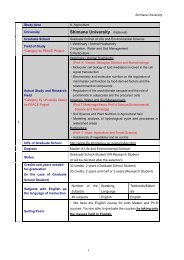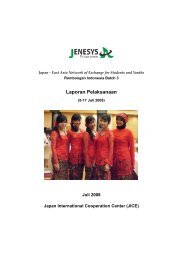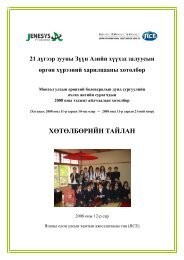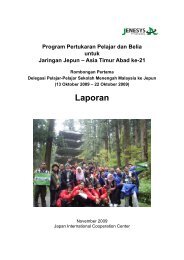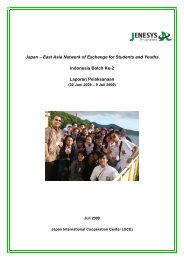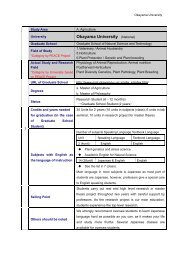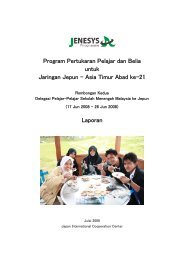Doshisha University (Private)
Doshisha University (Private)
Doshisha University (Private)
You also want an ePaper? Increase the reach of your titles
YUMPU automatically turns print PDFs into web optimized ePapers that Google loves.
Prof. Hideichi SASAOKA, Hisato IWAI<br />
Laboratory of Communication Systems<br />
http://istc.doshisha.ac.jp/course/electrical/labo_23.html<br />
Research Contents<br />
In our laboratory we are researching technologies related to system configuration, wireless transmission, and radio wave<br />
propagation in various wireless communications systems. In particular, we aim to advance mobile communications by researching<br />
fundamental technologies such as wireless security, coding technologies, next generation mobile communications<br />
systems/technologies, radio wave propagation, and wireless measurement technologies. Our goal is to contribute to the realization<br />
of future multimedia mobile communications. Researches on these items are carried out by investigating new methods and<br />
technologies and evaluating their effectiveness with computer simulations and indoor/outdoor wireless experiments.<br />
Our major research themes are the technologies in the fields of mobile communications and other wireless communications<br />
described below.<br />
Wireless encryption/security, coding technologies in order to realize safer, even more reliable communications<br />
Next generation mobile communications system/technologies in order to realize communications that are easy for users to<br />
use at even higher speeds and lower costs<br />
Radio wave propagation, wireless measurement technologies in order to establish reliable and economic service areas and<br />
to eliminate/avoid interference from other cells and wireless communications<br />
Wireless encryption/security, coding technology<br />
In wireless communications, all information is naturally transmitted with wireless channels in the air. Different from wired signal<br />
transmission where the transmission point and reception point are connected by a cable and the signal only propagates in a limited<br />
range, in wireless signal transmissions reception locations basically cannot be limited. There are security risks present in wireless<br />
signal transmission such as information eavesdropping, unauthorized usage of wireless networks, and falsification. Wireless LAN<br />
security, which has recently become a problem, is a typical example of this. For the problem, our laboratory is focusing on a method<br />
to share a private key between sending and receiving devices to prevent information interception/leakage by encryption. The<br />
principle of the method is based on the reversibility (reciprocity) and locality of wireless channels. By the method, a private key is<br />
shared between sending and receiving devices without transmitting key information over wireless channels. For this method, we run<br />
computer simulations that assume the propagation environment and qualitatively evaluate its performance.<br />
In addition, we are also conducting research on error-correcting codes as a technology to improve transmission reliability of wireless<br />
communications. In particular, centered on a combination with adaptive modulation and adaptive coding technologies, we are<br />
working to research and develop new error-correcting codes suited to recent broadband wireless communications.<br />
Next generation mobile communications system/technology<br />
In the mobile communications field, in continuation of the first generation (1G) analog automobile telephone system, the second<br />
generation (2G) early digital mobile communications system, and the third generation (3G) communications system advanced in<br />
high speeds and international standards, currently research and development of the so-called fourth generation (4G) of the mobile<br />
communications system is moving forward. In the fourth generation system, instead of a concept where a single large system<br />
comprehensively supports the entire environment and services, a concept where multiple systems are split up according to the<br />
usage environment or application, for example cellular communications to cover wide areas and wireless LANs suited to high-speed<br />
transmissions, is envisioned. The general idea is to call this collection of multiple systems "4G." A large increase in transmission<br />
capacity is also necessary with the personalization and ubiquity of wireless communications. The implementation of broadband



